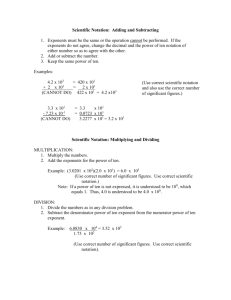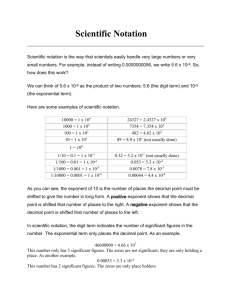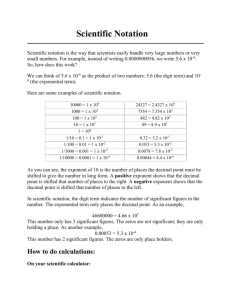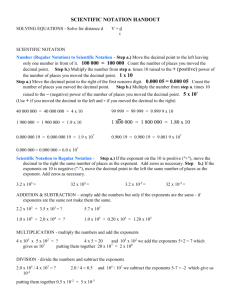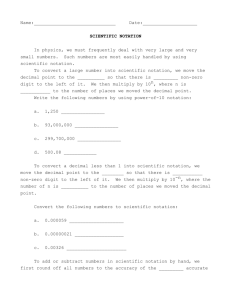Algebra Seminar Session 4 Study Guide
advertisement
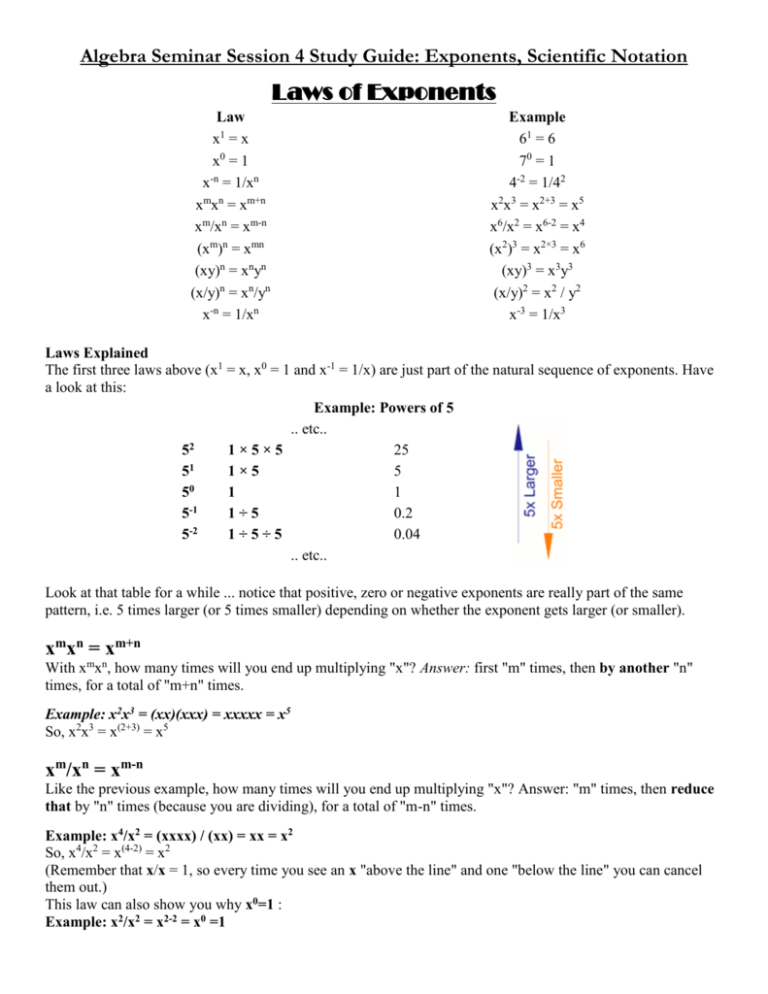
Algebra Seminar Session 4 Study Guide: Exponents, Scientific Notation Laws of Exponents Law x1 = x x0 = 1 x-n = 1/xn xmxn = xm+n xm/xn = xm-n (xm)n = xmn (xy)n = xnyn (x/y)n = xn/yn x-n = 1/xn Example 61 = 6 70 = 1 4-2 = 1/42 x2x3 = x2+3 = x5 x6/x2 = x6-2 = x4 (x2)3 = x2×3 = x6 (xy)3 = x3y3 (x/y)2 = x2 / y2 x-3 = 1/x3 Laws Explained The first three laws above (x1 = x, x0 = 1 and x-1 = 1/x) are just part of the natural sequence of exponents. Have a look at this: Example: Powers of 5 .. etc.. 2 25 5 1×5×5 1 5 5 1×5 1 50 1 -1 0.2 5 1÷5 -2 0.04 5 1÷5÷5 .. etc.. Look at that table for a while ... notice that positive, zero or negative exponents are really part of the same pattern, i.e. 5 times larger (or 5 times smaller) depending on whether the exponent gets larger (or smaller). xmxn = xm+n With xmxn, how many times will you end up multiplying "x"? Answer: first "m" times, then by another "n" times, for a total of "m+n" times. Example: x2x3 = (xx)(xxx) = xxxxx = x5 So, x2x3 = x(2+3) = x5 xm/xn = xm-n Like the previous example, how many times will you end up multiplying "x"? Answer: "m" times, then reduce that by "n" times (because you are dividing), for a total of "m-n" times. Example: x4/x2 = (xxxx) / (xx) = xx = x2 So, x4/x2 = x(4-2) = x2 (Remember that x/x = 1, so every time you see an x "above the line" and one "below the line" you can cancel them out.) This law can also show you why x0=1 : Example: x2/x2 = x2-2 = x0 =1 (xm)n = xmn First you multiply "m" times. Then you have to do that "n" times, for a total of m×n times. Example: (x3)4 = (xxx)4 = (xxx)(xxx)(xxx)(xxx) = xxxxxxxxxxxx = x12 So (x3)4 = x3×4 = x12 (xy)n = xnyn To show how this one works, just think of re-arranging all the "x"s and "y" as in this example: Example: (xy)3 = (xy)(xy)(xy) = xyxyxy = xxxyyy = (xxx)(yyy) = x3y3 x-y =1/xy (x/y)n = xn/yn Similar to the previous example, just re-arrange the "x"s and "y"s Remember this law from the table at the beginning of this study guide. Example: (x/y)3 = (x/y)(x/y)(x/y) = (xxx)/(yyy) = x3/y3 Example: 3-2 = 1/32 = 1/9 From: http://www.mathsisfun.com/algebra/exponent-laws.html Scientific Notation Scientific notation is the way that scientists easily handle very large numbers or very small numbers. For example, instead of writing 0.0000000056, we write 5.6 x 10-9. So, how does this work? We can think of 5.6 x 10-9 as the product of two numbers: 5.6 (the digit term) and 10-9 (the exponential term). Here are some examples of scientific notation. As you can see, the exponent of 10 is the number of places the decimal point must be shifted to give the number in long form. A positive exponent shows that the decimal point is shifted that number of places to the right. A negative exponent shows that the decimal point is shifted that number of places to the left. 10000 = 1 x 104 1000 = 1 x 103 100 = 1 x 102 10 = 1 x 101 1 = 100 1/10 = 0.1 = 1 x 10-1 1/100 = 0.01 = 1 x 10-2 1/1000 = 0.001 = 1 x 10-3 1/10000 = 0.0001 = 1 x 10-4 24327 = 2.4327 x 104 7354 = 7.354 x 103 482 = 4.82 x 102 89 = 8.9 x 101 (not usually done) 0.32 = 3.2 x 10-1 (not usually done) 0.053 = 5.3 x 10-2 0.0078 = 7.8 x 10-3 0.00044 = 4.4 x 10-4 In scientific notation, the digit term indicates the number of significant figures in the number. The exponential term only places the decimal point. As an example, 46600000 = 4.66 x 107 This number only has 3 significant figures. The zeros are not significant; they are only holding a place. As another example, 0.00053 = 5.3 x 10-4 This number has 2 significant figures. The zeros are only place holders. Operations with Scientific Notation You will need to be familiar with exponents since your calculator cannot take care of them for you. For an introduction to rules concerning exponents, see the section on Manipulation of Exponents. Addition and Subtraction: Find the standard form of each number in parenthesis, then add or subtract them. Rewrite the sum or difference in scientific notation if needed. Example: (4.215 x 10-2) + (3.2 x 10-4) = (.04215) + (.00032) = .04279 or 4.247 x 10-2 Example: (8.97 x 104) - (2.62 x 103) = (89,700) - (2620) = 87,080 or 8.708 x 104 Multiplication: The digit terms are multiplied in the normal way and the exponents are added. The end result is changed so that there is only one nonzero digit to the left of the decimal. Example: (3.4 x 106)(4.2 x 103) = (3.4)(4.2) x 10(6+3) = 14.28 x 109 = 1.4 x 1010 (to 2 significant figures) Example: (6.73 x 10-5)(2.91 x 102) = (6.73)(2.91) x 10(-5+2) = 19.58 x 10-3 = 1.96 x 10-2 (to 3 significant figures) Division: The digit terms are divided in the normal way and the exponents are subtracted. The quotient is changed (if necessary) so that there is only one nonzero digit to the left of the decimal. Example: (6.4 x 106)/(8.9 x 102) = (6.4)/(8.9) x 10(6-2) = 0.719 x 104 = 7.2 x 103 (to 2 significant figures) Example: (3.2 x 103)/(5.7 x 10-2) = (3.2)/(5.7) x 103-(-2) = 0.561 x 105 = 5.6 x 104 (to 2 significant figures) Powers of Exponentials: The digit term is raised to the indicated power and the exponent is multiplied by the number that indicates the power. Example: (2.4 x 104)3 = (2.4)3 x 10(4x3) = 13.824 x 1012 = 1.4 x 1013 (to 2 significant figures) Example: (6.53 x 10-3)2 = (6.53)2 x 10(-3)x2 = 42.64 x 10-6 = 4.26 x 10-5 (to 3 significant figures) From: http://www.chem.tamu.edu/class/fyp/mathrev/mr-scnot.html
